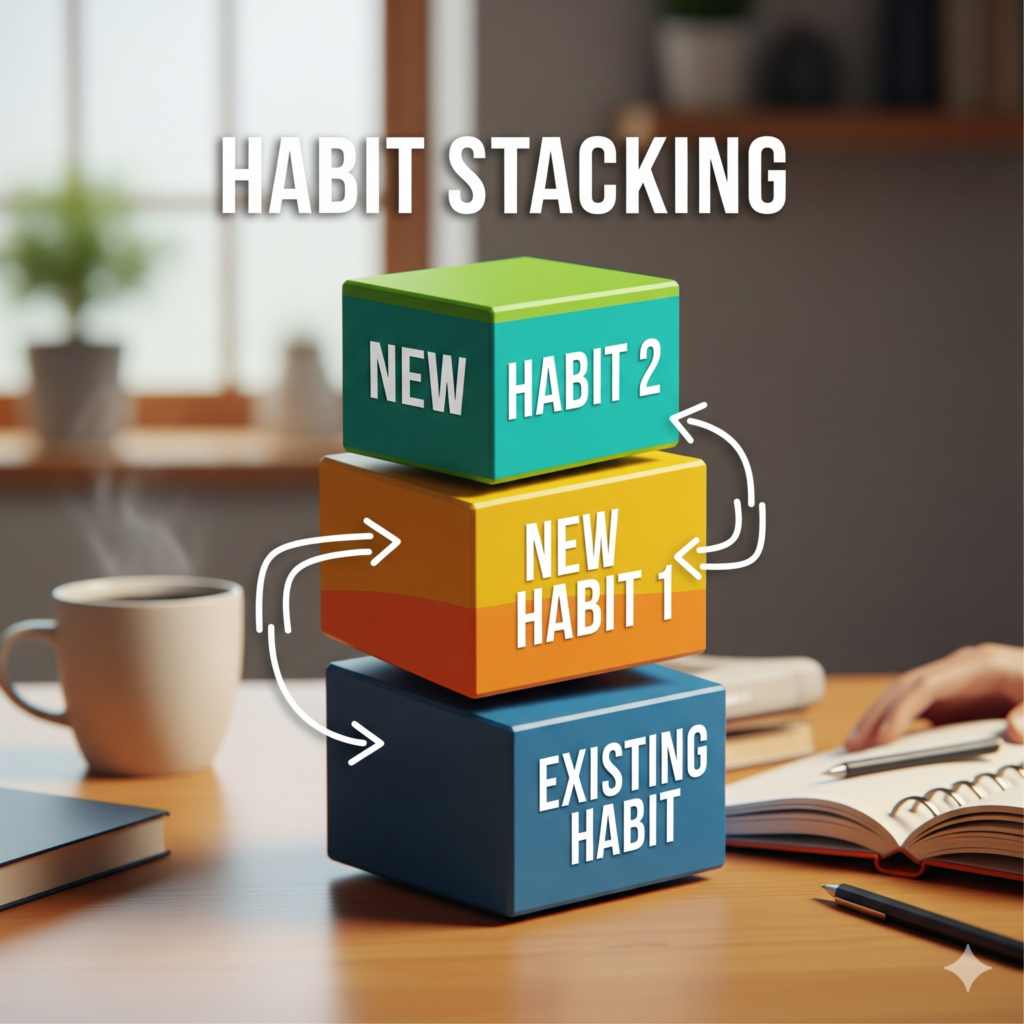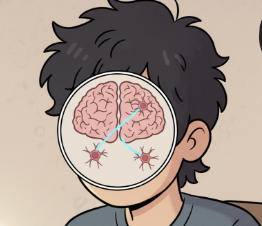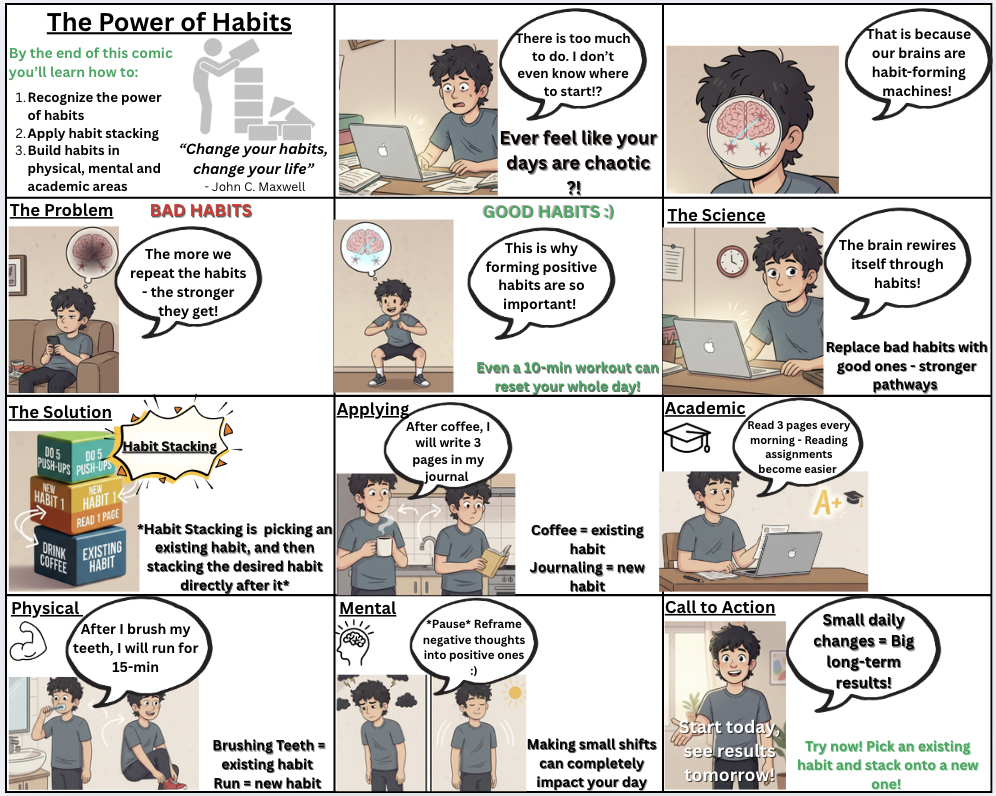Challenge A: Comic
The Power of Habits: an Educational Comic
Author: Alexis Moore
I am creating this comic given my educational background in psychology and business. I am passionate about exploring topics in this area. I chose this topic because I want to educate others about the impact small habits can have on one’s individual life. My goal for this project is to present something that I am proud of and for my comic to have high understandability.
THE PROCESS
Understand (Discover, Interpret, Specify)
DESCRIBE THE CHALLENGE:
Many students and adolescents struggle to break negative habits and build positive ones due to the fact that they do not understand how habits are formed in their brains. This lack of awareness often leads to cycles of procrastination, stress, and poor time management. The challenge of this project is to improve learners’ understanding of the power of habits and demonstrate how habit stacking can help them develop small, positive behaviours that support long-term success.
CONTEXT AND AUDIENCE:
Audience
The target audience is 18-30 year olds who want to improve their lives academically, physically, mentally or spiritually.
This audience is often navigating:
- Academic demands (study pressures, procrastination, exam stress)
- Irregular routines (sleep disruption, poor nutrition, lack of nutrition)
- Stressors (financial strain, work-life balance, social commitments)
Routines are difficult to navigate when having so many elements to balance. Small shifts in daily behaviour can significantly influence long-term success and well-being. By showing how habits are built and reshaped, this project supports learners in taking control of their lives. Feeling stuck in a habit loop can lead to burnout, as well as mental and physical exhaustion. This comic hopefully will provide some insight into how you can make minuscule behavioural adjustments, which in turn can transform your daily life overall.
Needs
Students in this age group (my target audience) need accessible tools/strategies to help them:
- Understand how habits are formed and why they are powerful
- Understand how to break negative cycles of procrastination
- Build positive routines using strategies such as habit stacking
- Give examples from different areas of life: academic, mental, and physical
- Create an engaging, clear comic that avoids overwhelming them
Goals
The overall goal for the audience is to gain new strategies to build positive habits and replace negative ones. This will support their academic success as well as improve their overall well-being. The goal of this project is for students to see that small, consistent changes can have long-term impacts on their health, motivation, and productivity.
Motivations
Students will feel motivated by the comic because of the appealing format. I have ensured that the material is approachable and engaging. I made sure there are clear visuals and the comic is relatable. In addition to that, my educational comic highlights personal growth; many adolescents are searching for ways to improve their daily routines, perform better in school, and reduce stress overall.
POV STATEMENT:
University students who are struggling to balance tasks in their lives and have a consistent routine. They need to change their habits to positively change their life.
LEARNING OBJECTIVES:
- Explain what habits are and how they are formed
- Recognize how small daily decisions can make long-term impacts
- Differentiate between helpful and unhelpful habits in daily life
- Apply habit-building techniques to their own routines
Plan (Ideate, Sketch, Elaborate)
IDEATION:
- When I was reading the criteria for this educational comic, I knew I wanted to do something that would relate to the same demographic that I am in. I was brainstorming and started reflecting on how small habits in my life make a large impact long-term because of how busy I am in my day-to-day life. I then started thinking about habit-stacking and how learning these two years ago has positively impacted my life. I knew then that I wanted to make an educational comic on the power of our habits and highlight habit stacking in the comic as well. I used Gemini 2.5 to help create my images and gave it a very specific prompt.
Prompt: Hi Gemini! Can you help me create 12 images for an educational comic I will be creating on Canva, titled The Power of Habits. I want the visuals to be clear and expressive in the person’s face, so that it will allow me to create a storyline. I am going to be focusing on the importance of building good habits. In the first image, please focus on a person at their computer who looks stressed, then the next image, please show an outline of a person with an image of the brain firing. Then, show me an image of what the brain looks like when doing a negative habit, and then directly after, show me a positive habit. In the next image, please show me the same person at their computer looking intrigued (not stressed anymore), then please showcase habit stacking with blocks as the visual, then on the blocks show an example of a simple everyday habit like “drink coffee as an existing habit and then do 5 push-ups as the desired habit.
Then, in the next image, please make the person have a cup of coffee in their hands, and directly beside, in the same image please make the same person hold a book. Following that, please make an image of the person sitting at their computer getting a good grade next, show one image and the person on the left brushing their teeth, and the same person directly beside putting on their runners. Next, show two images side by side in the same image, show the one on the left in a negative headspace and the one on the right in a positive headspace. Lastly, please show the person gesturing their hand out so it looks like they are telling the audience something in a positive way!
The bias the AI generator created was that it produced a male that is Eurocentric in my comic.

*This image is created by gemini-flash*
I loved the way that the generator showcased habit-stacking. It depicted how I see it in my brain.
STORYBOARD OR SCRIPT:
- Here are two screenshots below of the first two images that Gemini created, given my two initial prompts.


Image 1) Depicts a stressed student with multiple deadlines
Image 2) Shows the inside of your brain when habits are forming
PRINCIPLES APPLIED:
I decided to focus on Mayer’s theory of multimedia learning to enhance the quality of the comic. As mentioned previously in my substantial post, I really wanted to ensure that my educational comic avoided redundant information. To guarantee this, I wanted to make sure my comic had limited text, clear visuals, and figures that not only engaged the reader but made it easier to understand. In addition, I wanted to incorporate the Dual Coding Theory as well as it stood out to me when I was initially reading the theories of multimedia. It states that it is easier to retain information when a visual is paired with it; I made sure to add extra visual aids in my comic when possible to help support the reader.
- Reduce redundancy
- Encorporate Dual Coding Theory
Create and Share the Prototype

PEER FEEDBACK:
- I read over Emma’s feedback, and I took a couple of different steps to improve my comic. I highlighted key points to make it more interesting to the reader and highlighted the “bad habits” in red and the “good habits” in green to make them stand out more. I also altered the text in the 5th box as mentioned, so it is not the same text as the previous one. I thought that the repetitiveness would reiterate my point, but after receiving feedback, the repetitiveness was not beneficial, so I changed the text.
- I looked over Nico’s feedback and made sure that I made a section highlighting the science aspect of habit forming. I tried to make the comic more motivational by adding an interactive piece at the end. I appreciated both the feedback and the tweaks that I made from the feedback that I received. I feel as though it improved it a lot.
Reflect and Refine
REFLECTION:
Creating this educational comic challenged me to think critically about how information is presented and understood. At the start, I underestimated how difficult it would be to clearly communicate complex topics such as habit formation in a simple and comprehensible way. I quickly figured out that reducing the amount of text on the comic was necessary to make it highly engaging and improve the clarity of the comic. After comparing my initial comic draft to my final one, it is clear that focusing on visuals that help support the text helped make the comic significantly more pleasant to view. This aligned with Mayer’s multimedia principles and reinforced for me the importance of the design of the comic.
A roadblock I faced was creating a prompt that worked well for what I wanted for my comic. It was more difficult than I expected, and I had to reword the prompt to make it more specific; after three tries, I got it to make an image that looked similar to what I imagined. I had to continue to refine my language each time to get closer to the type of images that I wanted. Even though it was frustrating, it taught me how precise you need to be when working with AI technology.
Peer feedback helped to improve an improved version. Many of the critiques that you receive, you would not think of yourself, so getting two new perspectives on the comic was very helpful. I am grateful for the feedback because I feel that it changed the overall look of my comic and helped me improve it. Emma’s suggestion to avoid repetitiveness pushed me to edit almost all of my text boxes to make them more concise, and I highlighted habits in colour (red for negative, green for positive) for added clarity. Nico’s feedback encouraged me to make the comic more motivational, so I decided to incorporate an interactive element at the end, which I like how it turned out.
Looking back, my initial draft was informative, but the final version was much more engaging and memorable to the target audience. I am happy with how my project turned out, and I now understand that designing educational comics is not just about presenting the information but helping guide the readers through thoughtful visuals, activity, and structure.
References:
Canva. (2025). Canva. https://www.canva.com/
GeminiFlash.(2025). GoogleDeepMind (September 25 version) https://deepmind.google/models/gemini/flash
Theories of Multimedia Learning. EDCI 337. (2025). https://edtechuvic.ca/edci337/2025/09/05/theories-of-multimedia-learning/